If you live in an area that gets lots of snow, you know how it can pile on a pool cover. One big blizzard and you’ve got an accumulation that can damage the material AND the pool unless you clear it away fast. If this is your first cold season as a pool owner, you’re likely wondering how to remove snow from the pool cover without spending too much time or energy.
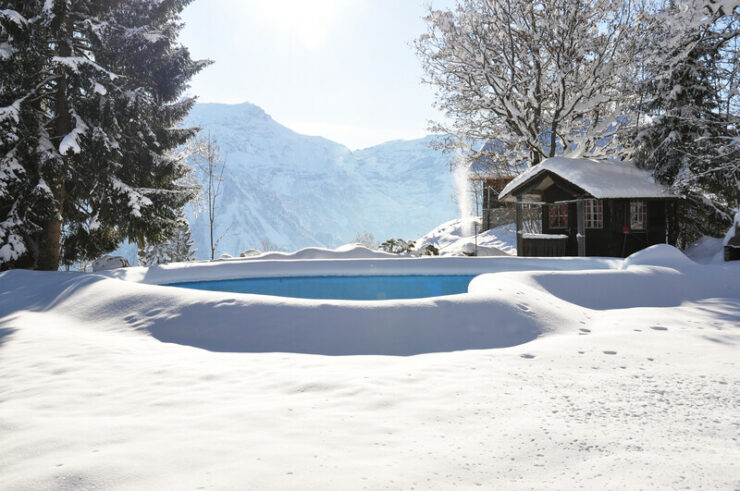
The good news is that keeping your swimming pool cover clear this winter doesn’t have to be time-consuming or expensive. Using the right tools for your cover type, you can get rid of snow and ice with little effort until spring rolls around, and you’re golden!
Should You Remove Snow From a Pool Cover?
It’s essential to remove snow from a winter pool cover for above-ground and inground pools. Excessive snow will damage all types of pool covers, including mesh safety covers, automatic covers, vinyl safety covers, and tarp pool covers.
When snowflakes fall on your face and hands, it doesn’t feel like much, does it? Cold, maybe, but weightless.
Now, think back to the time you were hit by a snowball. When it’s densely packed, the white stuff’s heavy enough to leave a bruise- or at least have you swearing revenge.
It’s the same deal with your pool cover. A light dusting of snow won’t do much, but a couple of feet can put a strain on the cover and even the pool, especially if it’s an above-ground variety. Look at it this way:
- On average, snow weighs anywhere from four to over 12 pounds per cubic foot.
- The higher it piles, the heavier it gets.
If you’ve got a pool that’s 10 feet in diameter, you’re potentially looking at a huge weight that can leave you with a bigger repair bill come spring. It doesn’t matter what kind of pool you have either- heavy snow buildup is bad news.
- With an above-ground pool cover, the added weight puts more strain on the cover. Since the cover is attached to the pool walls using straps, you’re looking at major strain at best and wall collapse at worst.
- While an inground pool won’t collapse, an inground pool winter cover can cave under the weight. With heavy snow accumulation, the cover’s anchors and even the pool’s coping could pop out. (obviously, this isn’t good.) And if you’ve got an automatic pool cover, the weight of the snow may bend or break it.
Before we get into how to remove snow from a pool cover, let’s review some considerations based on cover type.
Snow on Tarp cover or Regular Plastic Covers
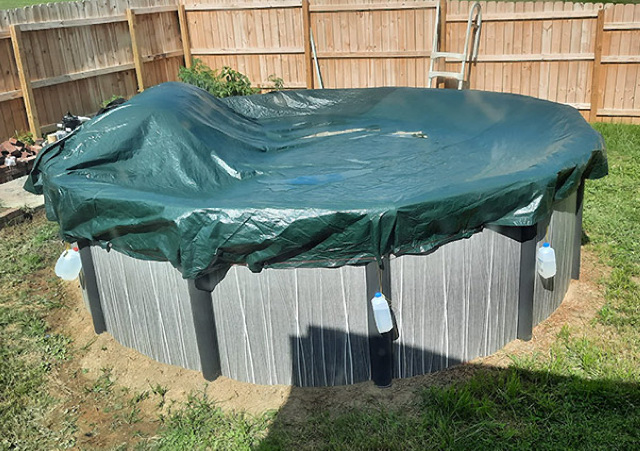
If you’ve got a regular plastic swimming pool cover, you’ll want to make sure that the water level in the wintertime is 3-6” below the skimmer opening. Regular covers need support from the water; otherwise, they can tear or collapse under a load of heavy snow. You’ll also want to clear away any melting snow more quickly, as anything over an inch can damage the cover.
Snow on Solid Safety Covers or Automatic Covers
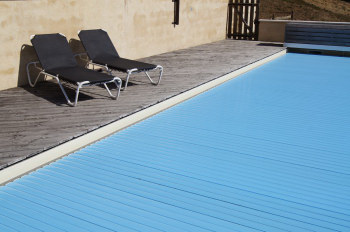
Although these covers are rated to hold a reasonable amount of weight, they’re not usually designed to hold the weight of large amounts of snow. Your best bet is to use a mesh safety cover for the winter instead. But if you insist on using your automatic cover, regularly remove the snow from it. Don’t be tempted to open it during winter, too, as ice may freeze the mechanism.
Snow on Mesh Safety Covers
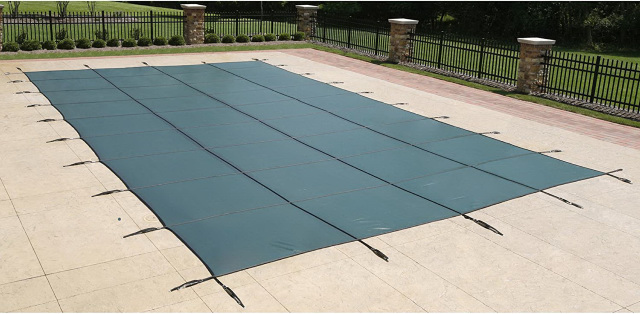
With a winter mesh safety pool cover, you’ll also want to have the water about 3-6” below the skimmer. When you do get snow on the cover, this will help support the weight. Try to remove the snow frequently. Whatever you do, don’t try to break it free from ice or use a metal snow shovel, as you risk damaging it.
How to Remove Snow From Pool Covers – the Right Way!
Different tools are available to keep your pool cover clear from snow. The right solution for you will depend on the characteristics of the snow as well as the cover and pool.
If you’ve got a light dusting of snow, your options include the following:
- Soft-Bristled Broom or Pool Brush: Use your broom to sweep away light accumulations. This works for all pools and covers.
- Leaf Blower: If your broom is too short of reaching the middle of the cover, a handheld leaf blower can get rid of the rest unless the snow is wet and super-dense.
- Pool Salt: Pool salt is a great way to get rid of light snowfalls if you don’t have a leaf blower or a long enough broom handy. It will melt the snow a little. It should be pool salt, not rock salt or commercial ice melt for sidewalks.
Snow accumulations that are icy or more significant call for tools like the following:
- Ice Scrapers: Make sure you choose one like this 61″ ice scraper and snow broom. Although designed for car windshields, it’s made of durable foam that won’t scratch or tear your pool cover.
- Pool Cover Pump: If you’ve got a solid cover or tarp cover, you’ll need a pool cover pump to deal with water from melting snow: all it can take is a couple of inches of standing water to damage the cover. The Little Giant APCP-1700 automatically comes on when water accumulation reaches two inches: this convenience will make it your best friend during a messy winter.
- Waterproof Heat Cable: During a storm, a heated cable will help speed up the melting of snow from your pool cover. You can get them for under $40 at most hardware stores. To use, wrap it around the cover pump power cord and plug it in along with the pump.
More Tips for Removing the Snow from Your Pool Cover
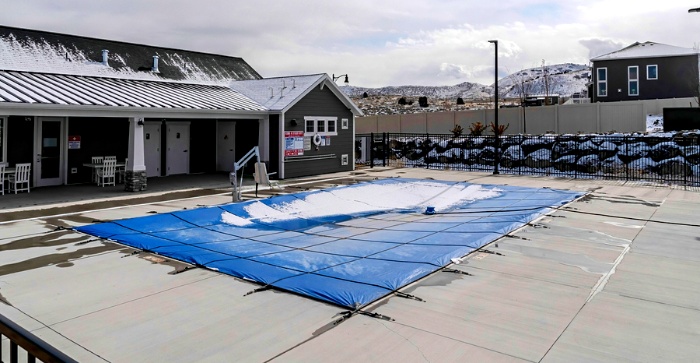
You don’t have to wait for the snow to pile up to spring into action. Sure, this part is a bit more work, but it’s still easy!
Preventing snow accumulation means clearing away small amounts at a time instead of doing one major sweep. It’s a little more time-consuming, but compared to hacking away a ton of wet snow and ice, it’s a breeze.
When you’re expecting a lot of snow, clear off the pool cover at the same time you tackle your front walk and driveway. You have to be out there anyway, right? That bit of extra exercise will do you- and your pool cover- good.
Using all these tips and tools, you can keep your above-ground pool cover or inground pool winter cover in prime shape until summer returns, and all the cold and snow is a distant memory. Trust us- that extra effort will pay off when you take that first warm-weather plunge and know that you’ve protected your investment for another year.
Related Reading:

